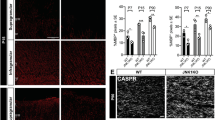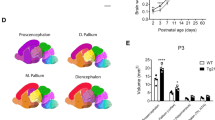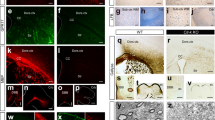Abstract
Cellular strategies for oligodendrocyte regeneration and remyelination involve characterizing endogenous neural progenitors that are capable of generating oligodendrocytes during normal development and after demyelination, and identifying the molecular signals that enhance oligodendrogenesis from these progenitors. Using both gain- and loss-of-function approaches, we explored the role of epidermal growth factor receptor (EGFR) signaling in adult myelin repair and in oligodendrogenesis. We show that 2′,3′-cyclic nucleotide 3′-phosphodiesterase (CNP) promoter–driven overexpression of human EGFR (hEGFR) accelerated remyelination and functional recovery following focal demyelination of mouse corpus callosum. Lesion repopulation by Cspg4+ (also known as NG2) Ascl1+ (also known as Mash1) Olig2+ progenitors and functional remyelination were accelerated in CNP-hEGFR mice compared with wild-type mice. EGFR overexpression in subventricular zone (SVZ) and corpus callosum during early postnatal development also expanded this NG2+Mash1+Olig2+ progenitor population and promoted SVZ-to-lesion migration, enhancing oligodendrocyte generation and axonal myelination. Analysis of hypomorphic EGFR-mutant mice confirmed that EGFR signaling regulates oligodendrogenesis and remyelination by NG2+Mash1+Olig2+ progenitors. EGFR targeting holds promise for enhancing oligodendrocyte regeneration and myelin repair.
This is a preview of subscription content, access via your institution
Access options
Subscribe to this journal
Receive 12 print issues and online access
$209.00 per year
only $17.42 per issue
Buy this article
- Purchase on SpringerLink
- Instant access to full article PDF
Prices may be subject to local taxes which are calculated during checkout








Similar content being viewed by others
References
Levine, J.M., Reynolds, R. & Fawcett, J.W. The oligodendrocyte precursor cell in health and disease. Trends Neurosci. 24, 39–47 (2001).
Stangel, M. & Hartung, H.P. Remyelinating strategies for the treatment of multiple sclerosis. Prog. Neurobiol. 68, 361–376 (2002).
Coskun, V. & Luskin, M.B. Intrinsic and extrinsic regulation of the proliferation and differentiation of cells in the rodent rostral migratory stream. J. Neurosci. Res. 69, 795–802 (2002).
Suzuki, S.O. & Goldman, J.E. Multiple cell populations in the early postnatal subventricular zone take distinct migratory pathways: a dynamic study of glial and neuronal progenitor migration. J. Neurosci. 24, 4240–4250 (2003).
Aguirre, A. & Gallo, V. Postnatal neurogenesis and gliogenesis in the olfactory bulb from NG2-expressing progenitors of the subventricular zone. J. Neurosci. 24, 10530–10541 (2004).
Aguirre, A.A., Chittajallu, R., Belachew, S. & Gallo, V. NG2-expressing cells in the subventricular zone are type C-like cells and contribute to interneuron generation in the postnatal hippocampus. J. Cell Biol. 165, 575–589 (2004).
Moreau-Fauvarque, C. et al. The transmembrane semaphorin Sema4D/CD100, an inhibitor of axonal growth, is expressed on oligodendrocytes and upregulated after CNS lesion. J. Neurosci. 23, 9229–9239 (2003).
Arnett, H.A. et al. bHLH transcription factor Olig1 is required to repair demyelinated lesions in the CNS. Science 306, 2111–2115 (2004).
Xin, M. et al. Myelinogenesis and axonal recognition by oligodendrocytes in brain are uncoupled in Olig1-null mice. J. Neurosci. 25, 1354–1365 (2005).
Cassiani-Ingoni, R. et al. Cytoplasmic translocation of Olig2 in adult glial progenitors marks the generation of reactive astrocytes following autoimmune inflammation. Exp. Neurol. 201, 349–358 (2006).
Chang, A., Nishiyama, A., Peterson, J., Prineas, J. & Trapp, B.D. NG2-positive oligodendrocyte progenitor cells in adult human brain and multiple sclerosis lesions. J. Neurosci. 20, 6404–6412 (2000).
Reynolds, R. et al. The response of NG2-expressing oligodendrocyte progenitors to demyelination in MOG-EAE and MS. J. Neurocytol. 31, 523–536 (2002).
Doetsch, F., Petreanu, L., Caille, I., Garcia-Verdugo, J.M. & Alvarez-Buylla, A. EGF converts transit-amplifying neurogenic precursors in the adult brain into multipotent stem cells. Neuron 36, 1021–1034 (2002).
Martens, D.J., Seaberg, R.M. & van der Kooy, D. In vivo infusions of exogenous growth factors into the fourth ventricle of the adult mouse brain increase the proliferation of neural progenitors around the fourth ventricle and the central canal of the spinal cord. Eur. J. Neurosci. 16, 1045–1057 (2002).
Kornblum, H.I., Yanni, D.S., Easterday, M.C. & Seroogy, K.B. Expression of the EGF receptor family members ErbB2, ErbB3 and ErbB4 in germinal zones of the developing brain and in neurosphere cultures containing CNS stem cells. Dev. Neurosci. 22, 16–24 (2000).
Anton, E.S. et al. Receptor tyrosine kinase ErbB4 modulates neuroblast migration and placement in the adult forebrain. Nat. Neurosci. 7, 1319–1328 (2004).
Marshall, C.A., Suzuki, S.O. & Goldman, J.E. Gliogenic and neurogenic progenitors of the subventricular zone: who are they, where did they come from, and where are they going? Glia 43, 52–61 (2003).
Aguirre, A., Rizvi, T.A., Ratner, N. & Gallo, V. Overexpression of the epidermal growth factor receptor confers migratory properties to nonmigratory postnatal neural progenitors. J. Neurosci. 25, 11092–11106 (2005).
Ling, B.C. et al. Role for the epidermal growth factor receptor in neurofibromatosis-related peripheral nerve tumorigenesis. Cancer Cell 7, 65–75 (2005).
Shields, S.A., Gilson, J.M., Blakemore, W.F. & Franklin, R.J. Remyelination occurs as extensively but more slowly in old rats compared to young rats following gliotoxin-induced CNS demyelination. Glia 28, 77–83 (1999).
Karimi-Abdolrezaee, S., Eftekharpour, E., Wang, J., Morshead, C.M. & Fehlings, M.G. Delayed transplantation of adult neural precursor cells promotes remyelination and functional neurological recovery after spinal cord injury. J. Neurosci. 26, 3377–3389 (2006).
Preston, R.J., Waxman, S.G. & Kocsis, J.D. Effects of 4-aminopyridine on rapidly and slowly conducting axons of rat corpus callosum. Exp. Neurol. 79, 808–820 (1983).
Luetteke, N.C. et al. The mouse waved-2 phenotype results from a point mutation in the EGF receptor tyrosine kinase. Genes Dev. 8, 399–413 (1994).
Yuan, X. et al. Expression of the green fluorescent protein in the oligodendrocyte lineage: a transgenic mouse for developmental and physiological studies. J. Neurosci. Res. 70, 529–545 (2002).
Menn, B. et al. Origin of oligodendrocytes in the subventricular zone of the adult brain. J. Neurosci. 26, 7907–7918 (2006).
Nait-Oumesmar, B. et al. Progenitor cells of the adult mouse subventricular zone proliferate, migrate and differentiate into oligodendrocytes after demyelination. Eur. J. Neurosci. 11, 4357–4366 (1999).
Armstrong, R.C., Le, T.Q., Frost, E.E., Borke, R.C. & Vana, A.C. Absence of fibroblast growth factor 2 promotes oligodendroglial repopulation of demyelinated white matter. J. Neurosci. 22, 8574–8585 (2002).
Murtie, J.C., Zhou, Y.X., Le, T.Q., Vana, A.C. & Armstrong, R.C. PDGF and FGF2 pathways regulate distinct oligodendrocyte lineage responses in experimental demyelination with spontaneous remyelination. Neurobiol. Dis. 19, 171–182 (2005).
Armstrong, R.C., Le, T.Q., Flint, N.C., Vana, A.C. & Zhou, Y.X. Endogenous cell repair of chronic demyelination. J. Neuropathol. Exp. Neurol. 65, 245–256 (2006).
Mason, J.L., Xuan, S., Dragatsis, I., Efstratiadis, A. & Goldman, J.E. Insulin-like growth factor (IGF) signaling through type 1 IGF receptor plays an important role in remyelination. J. Neurosci. 23, 7710–7718 (2003).
Knapp, P.E. & Adams, M.H. Epidermal growth factor promotes oligodendrocyte process formation and regrowth after injury. Exp. Cell Res. 296, 135–144 (2004).
Buffo, A. et al. Expression pattern of the transcription factor Olig2 in response to brain injuries: implications for neuronal repair. Proc. Natl. Acad. Sci. USA 102, 18183–18188 (2005).
Parras, C.M. et al. Mash 1 specifies neurons and oligodendrocytes in the postnatal brain. EMBO J. 23, 4495–4505 (2004).
Ferrer, I. et al. Transforming growth factor-alpha (TGF-alpha) and epidermal growth factor-receptor (EGF-R) immunoreactivity in normal and pathologic brain. Prog. Neurobiol. 49, 99–123 (1996).
Lisovoski, F. et al. Transforming growth factor alpha expression as a response of murine motor neurons to axonal injury and mutation-induced degeneration. J. Neuropathol. Exp. Neurol. 56, 459–471 (1997).
Jin, K. et al. Heparin-binding epidermal growth factor-like growth factor: hypoxia-inducible expression in vitro and stimulation of neurogenesis in vitro and in vivo. J. Neurosci. 22, 5365–5373 (2002).
Nieto-Sampedro, M., Gomez-Pinilla, F., Knauer, D.J. & Broderick, J.T. Epidermal growth factor receptor immunoreactivity in rat brain astrocytes. Response to injury. Neurosci. Lett. 91, 276–282 (1988).
Burrows, R.C., Wancio, D., Levitt, P. & Lillien, L. Response diversity and the timing of progenitor cell maturation are regulated by developmental changes in EGFR expression in the cortex. Neuron 19, 251–267 (1997).
Matthieu, J.M., Comte, V., Tosic, M. & Honegger, P. Myelin gene expression during demyelination and remyelination in aggregating brain cell cultures. J. Neuroimmunol. 40, 231–434 (1992).
Hidalgo, A. Interactive nervous system development: control of cell survival in Drosophila. Trends Neurosci. 25, 365–370 (2002).
Kessaris, N. et al. Competing waves of oligodendrocytes in the forebrain and postnatal elimination of an embryonic lineage. Nat. Neurosci. 9, 173–179 (2006).
Gensert, J.M. & Goldman, J.E. Endogenous progenitors remyelinate demyelinated axons in the adult CNS. Neuron 19, 197–203 (1997).
Goddard, D.R., Berry, M., Kirvell, S.L. & Butt, A.M. Fibroblast growth factor-2 inhibits myelin production by oligodendrocytes in vivo. Mol. Cell. Neurosci. 18, 557–569 (2001).
Mason, J.L. & Goldman, J.E. A2B5+ and O4+ Cycling progenitors in the adult forebrain white matter respond differentially to PDGF-AA, FGF-2, and IGF-1. Mol. Cell. Neurosci. 20, 30–42 (2002).
Irvin, D.K., Dhaka, A., Hicks, C., Weinmaster, G. & Kornblum, H.I. Extrinsic and intrinsic factors governing cell fate in cortical progenitor cultures. Dev. Neurosci. 25, 162–172 (2003).
Kessaris, N., Jamen, F., Rubin, L.L. & Richardson, W.D. Cooperation between sonic hedgehog and fibroblast growth factor/MAPK signalling pathways in neocortical precursors. Development 131, 1289–1298 (2004).
Kakita, A. & Goldman, J.E. Patterns and dynamics of SVZ cell migration in the postnatal forebrain: monitoring living progenitors in slice preparations. Neuron 23, 461–472 (1999).
Belachew, S. et al. Postnatal NG2 proteoglycan-expressing progenitor cells are intrinsically multipotent and generate functional neurons. J. Cell Biol. 161, 169–186 (2003).
Marcus, J. et al. Sulfatide is essential for the maintenance of CNS myelin and axon structure. Glia 53, 372–381 (2006).
Mason, J.L., Langaman, C., Morell, P., Suzuki, K. & Matsushima, G.K. Episodic demyelination and subsequent remyelination with the murine central system changes in axonal caliber. Neuropathol. Appl. Neurobiol. 27, 50–58 (2001).
Acknowledgements
We thank N. Ratner for the CNP-hEGFR mice, for encouragement and for valuable discussion. We thank F. Gage and J. Goldman for the gift of pNIT-GFP retrovirus, and D. Rowitch for the gift of anti-Olig1 and anti-Olig2 antibodies. We thank R. Armstrong and L.-J. Chew for their comments on this manuscript. We are particularly grateful to J. Corbin for discussion and for critically reading several versions of this manuscript. We also thank S. Temple, T. Haydar and B. Jablonska for their comments on an earlier version of the manuscript. We thank A. Baron-Van Evercooren for technical advice on the focal demyelination model and for discussion. We thank D. Bergles for technical advice on the experiments on compound action potentials. This work was supported by US National Institutes of Health R01NS045702 (V.G.), R21NS050463 (V.G.), and by US National Institutes of Health MRDDRC P30HD40677. Electron microscopy was performed at the Virginia Commonwealth University, Department of Neurobiology and Anatomy Microscopy Facility, supported, in part, with funding from US National Institutes of Health Center Core Grant 5P30NS047463.
Author information
Authors and Affiliations
Contributions
A.A. conducted all the experiments, except for the electrophysiology and electron microscopy, and wrote the manuscript together with V.G. J.L.D. performed the electron microscopy analysis, J.M.M. conducted the electrophysiology experiments and V.G. supervised the project and wrote the manuscript with A.A.
Corresponding author
Ethics declarations
Competing interests
The authors declare no competing financial interests.
Supplementary information
Supplementary Text and Figures
Supplementary Figures 1–10 (PDF 3659 kb)
Rights and permissions
About this article
Cite this article
Aguirre, A., Dupree, J., Mangin, J. et al. A functional role for EGFR signaling in myelination and remyelination. Nat Neurosci 10, 990–1002 (2007). https://doi.org/10.1038/nn1938
Received:
Accepted:
Published:
Issue Date:
DOI: https://doi.org/10.1038/nn1938
This article is cited by
-
The Effects of Cuprizone on Murine Subventricular Zone-Derived Neural Stem Cells and Progenitor Cells Grown as Neurospheres
Molecular Neurobiology (2023)
-
EGF signaling promotes the lineage conversion of astrocytes into oligodendrocytes
Molecular Medicine (2022)
-
Epidermal Growth Factor in the CNS: A Beguiling Journey from Integrated Cell Biology to Multiple Sclerosis. An Extensive Translational Overview
Cellular and Molecular Neurobiology (2022)
-
Endoplasmic Reticulum in Metaplasticity: From Information Processing to Synaptic Proteostasis
Molecular Neurobiology (2022)
-
Generation and Release of Neurogranin, Vimentin, and MBP Proteolytic Peptides, Following Traumatic Brain Injury
Molecular Neurobiology (2022)



